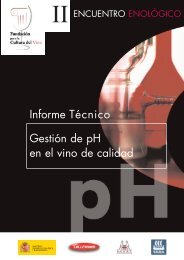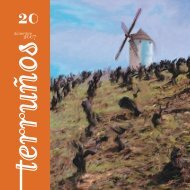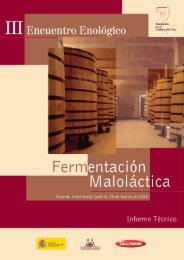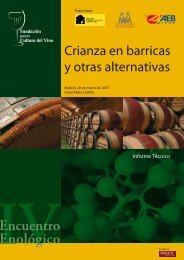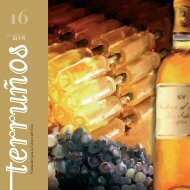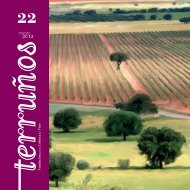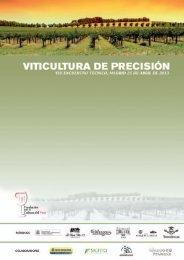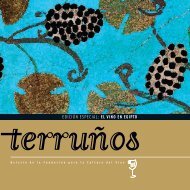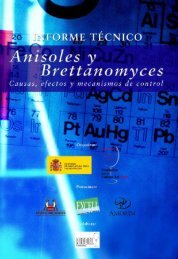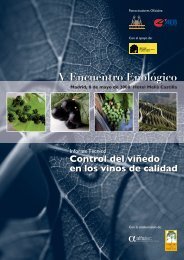Compuestos azufrados volátiles en vinos - Fundación para la ...
Compuestos azufrados volátiles en vinos - Fundación para la ...
Compuestos azufrados volátiles en vinos - Fundación para la ...
Create successful ePaper yourself
Turn your PDF publications into a flip-book with our unique Google optimized e-Paper software.
Effect of Micro-oxyg<strong>en</strong>ation on Color and Anthocyanin-Re<strong>la</strong>ted Compounds of Wines with Differ<strong>en</strong>t Ph<strong>en</strong>olic Cont<strong>en</strong>tsTable 1. Evolution of Some PhysicochemicalParameters during MO of Monastrell Wines apHtitratable acidity bvo<strong>la</strong>tile acidity cfree SO 2(mg/L)total SO 2(mg/L)acetaldehyde (mg/L)pHtitratable acidity bvo<strong>la</strong>tile acidity cfree SO 2(mg/L)total SO 2(mg/L)acetaldehyde (mg/L)pHtitratable acidity bvo<strong>la</strong>tile acidity cfree SO 2(mg/L)total SO 2(mg/L)acetaldehyde (mg/L)t 0t 1t 2t 3W13.725.870.39253922.2W23.666.310.33254129.1W33.636.450.40274832.3W1(C)3.785.760.40263213.5W2(C)3.715.830.33313523.0W3(C)3.665.700.37324425.6W1(MO)3.765.35*0.4122*28*12.8W2(MO)3.675.960.3422*3324.7W3(MO)3.665.560.3825*3523.2differ<strong>en</strong>t ph<strong>en</strong>olic cont<strong>en</strong>ts was investigated.MATERIALS AND METHODSW1(C)3.855.380.43375015.1W2(C)4.005.600.29386132.2W3(C)4.015.660.33266428.7W1(MO)3.835.17*0.47374916.6W2(MO)4.005.73*0.32336123.4*W3(MO)4.025.27*0.37296428.4W1(C)3.835.060.42224821.3W2(C)3.835.080.37165141.4W3(C)3.775.090.37166122.3W1(MO)3.79*4.90*0.3414*4632.6*W2(MO)3.804.900.3311*35*45.2W3(MO)3.784.89*0.39*11*38*35.0*aAn asterisk indicates significant differ<strong>en</strong>ces betwe<strong>en</strong>control and microoxyg<strong>en</strong>ated wines for each time considered.b Expressed as g/L of tartaric acid.cExpressed as g/L of acetic acid.Wine Samples. Three differ<strong>en</strong>t red wines, made fromVitis Vinifera var. Monastrell (2005 vintage), differingin their total ph<strong>en</strong>ol cont<strong>en</strong>t, were used for the experim<strong>en</strong>t(W1, W2, and W3). Each wine was distributedinto four 17 500 L tanks, and the MO experim<strong>en</strong>twas carried out in triplicate, with a control (C) andthree MO tanks for each type of wine. The heightof each tank was 4.5 m, <strong>en</strong>ough for the completedissolution of oxyg<strong>en</strong> microbubbles into the wine.MO began just after alcoholic ferm<strong>en</strong>tation had finished(November 7, 2005), applying a oxyg<strong>en</strong> doseof 10 mL/L/month. Malo<strong>la</strong>ctic ferm<strong>en</strong>tation (MLF)occurred spontaneously. Wh<strong>en</strong> MLF started (detectedby the decrease in malic acid), the MO systemwas stopped (November 30 for W1 and December20 for W2 and W3). During MLF, the bacteria consumethe acetaldehyde produced. They are capable ofmetabolizing acetaldehyde, ev<strong>en</strong> the acetaldehydebound to sulfur dioxide (25); therefore, any excess ofacetaldehyde produced during the MO process willdisappear.Wh<strong>en</strong> MLF was complete for all wines, SO 2was addedto leave the wines with a free SO 2cont<strong>en</strong>t close to 30mg/L, and MO was resumed (January 19, 2006). At thismom<strong>en</strong>t, the oxyg<strong>en</strong> supply was reduced to avoidaccumu<strong>la</strong>tion of acetaldehyde (3 mL/L/month). After2 months, the oxyg<strong>en</strong> supply was reduced again (1.5mL/L/month) before it was completely stopped. Thewine was analyzed immediately before the MO systembegan (t0), at the beginning of MLF (t1), wh<strong>en</strong> MO beganagain after MLF (t2), and 15 days after the MO systemwas stopped (t3) since wines take 8-10 days to absorbthe oxyg<strong>en</strong>, dep<strong>en</strong>ding on temperature and ph<strong>en</strong>oliccomposition of the wines (26). The MO system (AgrovinS.A., Alcazar de San Juan, Spain) was comprised of anoxyg<strong>en</strong> cylinder (food grade) and a dosing chamberthat allowed the doses of oxyg<strong>en</strong> flowing through ninediffer<strong>en</strong>t microdiffusers to be programmed.G<strong>en</strong>eral Determinations. pH and titratable aciditywere measured using an automatic titrator (Metrohm,Herisau, Switzer<strong>la</strong>nd). Vo<strong>la</strong>tile acidity was determinedaccording to the OIV Official Methods (27). Acetaldehydeand malic acid conc<strong>en</strong>tration were determinedusing <strong>en</strong>zymatic test kits from Roche Boehringer,Mannheim, Germany. The SO 2conc<strong>en</strong>tration (freeand total) was measured iodometrically by the Ripperprocedure (28) modified to detect the <strong>en</strong>d point pot<strong>en</strong>tiometricallywith an automatic titrator (Metrohm,Herisau, Switzer<strong>la</strong>nd).Id<strong>en</strong>tification and Quantification of Anthocyanins.Wines were analyzed by direct injection of thesamples previously filtered through a 45 μm nylon filter(Teknokroma, Barcelona, Spain). The HPLC analyseswere performed on a Waters 2690 liquid chromatograph(Waters, Milford, MA), equipped with aWaters996 diode array detector and a 250 mm × 4 mm i.d.,5 μm particle size Lichrocart RP-18 column (Merck,Darmstadt, Germany), using as solv<strong>en</strong>ts 4.5% aqueousformic acid (solv<strong>en</strong>t A) and acetonitrile (solv<strong>en</strong>t B) at aflow rate of 0.8 mL/ min. Elution was performed witha gradi<strong>en</strong>t starting with 10% B to reach 14.5% B at 30min, 15.2% B at 45 min, 18% B at 60 min, 25% B at 100min, and 25-100% B in 30 min. Chromatograms wererecorded at 520 nm.Compounds were id<strong>en</strong>tified by comparing their UVspectra recorded with the diode array detector andthose reported in the literature (11, 29). In addition,an HPLC-MS analysis was conducted to confirmeach peak id<strong>en</strong>tity. An LC-MSD-Trap VL-01036 liquidchromatograph-ion trap mass detector (Agil<strong>en</strong>t Technologies,Waldbronn, Germany) equipped with anelectrospray ionization (ESI) system was used. Elutionwas performed with the HPLC analysis conditionsdetailed previously. The heated capil<strong>la</strong>ry and voltagewere maintained at 350 °C and 4 kV, respectively.Mass scans (MS) were measured from m/z 300-1100.Mass spectrometry data were acquired in the positiveionization mode. Anthocyanins and anthocyanin-92



